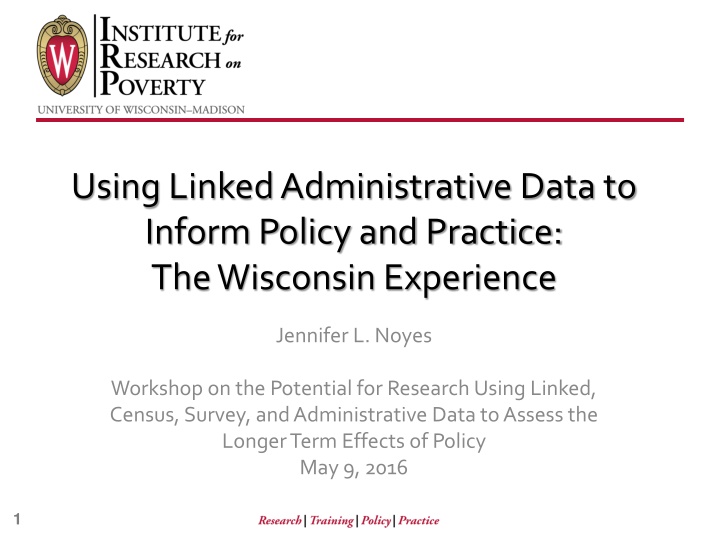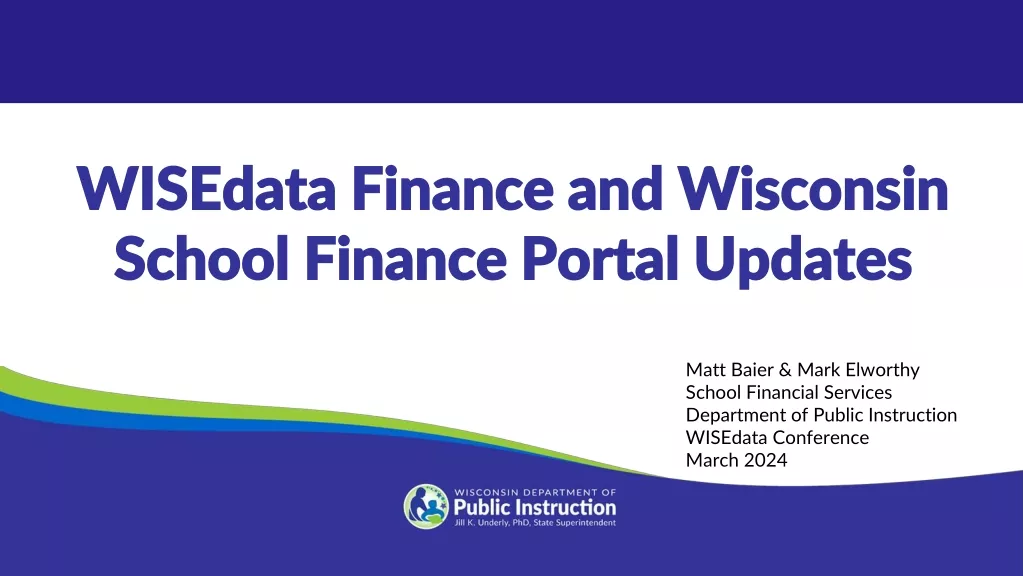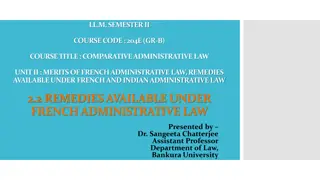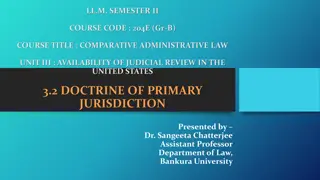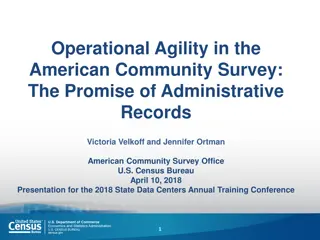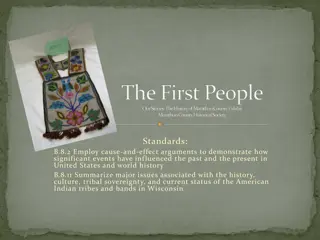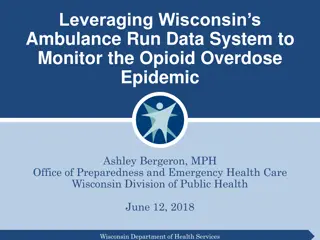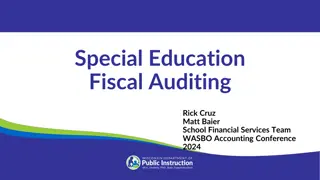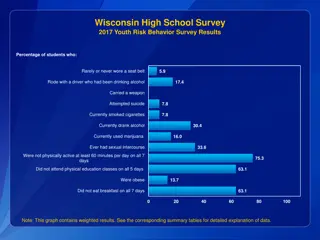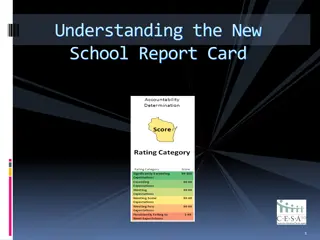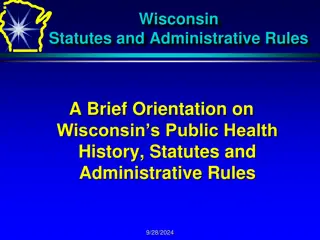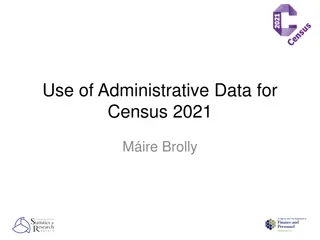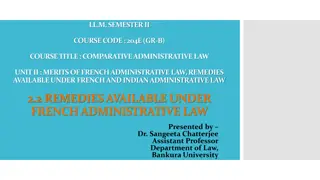Leveraging Wisconsin's Rich Administrative Data
How the Institute for Research on Poverty in Wisconsin utilizes a range of administrative data sources to inform policy decisions and drive academic research. Discover the background, collaboration logic, and current data resources available for comprehensive analysis.
Uploaded on Mar 10, 2025 | 1 Views
Download Presentation

Please find below an Image/Link to download the presentation.
The content on the website is provided AS IS for your information and personal use only. It may not be sold, licensed, or shared on other websites without obtaining consent from the author.If you encounter any issues during the download, it is possible that the publisher has removed the file from their server.
You are allowed to download the files provided on this website for personal or commercial use, subject to the condition that they are used lawfully. All files are the property of their respective owners.
The content on the website is provided AS IS for your information and personal use only. It may not be sold, licensed, or shared on other websites without obtaining consent from the author.
E N D
Presentation Transcript
Using Linked Administrative Data to Inform Policy and Practice: The Wisconsin Experience Jennifer L. Noyes Workshop on the Potential for Research Using Linked, Census, Survey, and Administrative Data to Assess the Longer Term Effects of Policy May 9, 2016 1
Outline 1. What administrative data is available to IRP researchers? 2. How has this data been used? 3. What have we learned that may be useful? 4. How might the proposed intergenerational panel be helpful? 2
IRP Data Core: Background History: Evolved from a series of large-scale evaluation projects conducted by IRP for the State of Wisconsin, including the Child Support Demonstration Evaluation CSDE (1997-2006) Funding: Primarily through research projects funded by grants and contracts from state and federal agencies; administrative support from UW-Madison and the IRP Core grant (USDHHS/ASPE) Purpose: Designed for research Not legally accurate Not in real time Complements agency approaches to day-to-day program management 3 3
IRP Data Core: Logic of Collaboration Collaboration Supports Policy Development and Academic Research Wisconsin State Agencies Policy issues Innovative programs Real-world experience Data Funding IRP University of Wisconsin-Madison University resources Technical expertise Long time horizon Funding 4 4
IRP Data Core: Current Wisconsin State Administrative Data Resources REGULAR MATCH: Wage Records (UI) Foreclosures (CCAP) SPECIALIZED MATCH: Department of Revenue Department of Public Instruction Juvenile Circuit Court Records OTHER MATCHES: SSI records (CARES) Vital Records (births/paternity) Circuit Court Records Family Court Record* TANF Applicants* Parent Surveys CORE: AFDC/TANF (CRN, CARES) SNAP/Food Stamps (CRN, CARES) Medicaid/BadgerCare (CRN, CARES) Child Care Subsidy Program (CARES) Child Support (KIDS) Unemployment Insurance Benefits (UI) Child Protective Services (WiSACWIS) Incarceration (Dept. of Corrections) Milwaukee Jail * Not electronic 5
IRP Data Core: Data Integration Creation of a Multi-Sample Person File (MSPF): demographics of all individuals in the data systems from the date of creation through most recently available year Structure: one record per individual, without distinction between adults and children, or between male and female Process: Match/merge all individuals from all primary data sources, using identifying variables with some combination of these traits: a) commonly recorded (name, sex) b) uniquely-identifying (SSN, ITIN) c) immutable (date of birth, place of birth) Complex and time-consuming to program (SAS) 6
IRP Data Core: Data Files In addition to MSPF: Case Files Parent/Child Files Participation Files (month or quarter, mid-1990s thru most recently available year) Cross-Walk ID files with other research subjects Other: location, race/ethnicity All files linkable by unique IRP-constructed Personal ID Updated & expanded each year 7
Important to Remember MSPF designed for research only; not legally accurate, given use of fuzzy/probabilistic matching techniques. 8
Outline 1. What administrative data is available to IRP researchers? 2. How has this data been used? 3. What have we learned that may be useful? 4. How might the proposed intergenerational panel be helpful? 9
Very Flexible, Many Options Options include, at a point in time and/or over time: Measuring participation across programs Understanding relationships between programs Measuring the effect of policies Analyzing outcomes by population Understanding family composition Understanding within person and intergenerational program participation dynamics 10
Example: Disconnection What are the reasons why program participants become disconnected from programs? Moved-up: experiencing increases in formal earnings (in UI system records) Aged out: experiencing youngest child aging out of eligibility for key programs (potentially relevant for households with children) Locked up: were incarcerated 11
Example: Child Welfare and Child Support What is the effect of child support income on the risk of maltreatment? How often are parents charged child support to offset costs? How often do they pay? Do child support orders to offset costs delay reunification? Or, do they motivate change by parents? 12
Example: Child Support Orders of Incarcerated Noncustodial Will NCPs with suspended orders during incarceration have better post-incarceration outcomes? Reduced arrears (a mechanical effect) Improved child support compliance Higher earnings in the formal economy Compared outcomes: Before/after policy implementation Milwaukee/Non-participating counties 13
Example: Child Welfare and Education What is the relationship between out of home placement and academic achievement for children in grades 3 through 8? Does academic achievement vary by placement characteristics? What is the relative strength of the relationship between school quality versus stability and educational outcomes for children in an out of home placement? 14
Example: What is the experience of children born to unmarried parents? 100% Dad half sibs 80% Mom & Dad half sibs 60% Mom half sibs 40% Only Full Sibs 20% No siblings 0% At Birth At Age 1 At Age 2 At Age 3 At Age 4 At Age 5 At Age 6 At Age 7 At Age 8 At Age 9 At Age 10 15
Example: Child Welfare and Incarceration What proportion of child welfare-involved children have an incarcerated parent? What proportion of children who were involved in the child welfare system subsequently become incarcerated? Of currently incarcerated adults, how many were child welfare involved as children? 16
Outline 1. What administrative data is available to IRP researchers? 2. How has this data been used? 3. What have we learned that may be useful? 4. How might the proposed intergenerational panel be helpful? 17
Key Challenge: Data Not Designed for Research Most records not designed with a strict requirement to maintain a single record per individual Each program privileges the data most critical to its mission There is no commonly agreed upon set of high quality identifying variables Agencies with distinct missions face challenges in determining which data source takes precedence or how conflicts should be resolved Data sets change over time and historical records of these changes need to be maintained Access to the data predicated on research being of interest to the data custodian, in compliance with established statutes and regulations 18
Key Considerations: Data Construction Whether to use samples or the universe of individuals? How to structure the data: by individual, case, family unit, or child/adult status? What are useful identifying variables? How to pre-process or clean administrative data? How to address considerations of legally accurate data, fuzzy matching, over-matching, under-matching, and cross-matching? How to determine which matching technique to use (deterministic, probabilistic, or a mix of the two)? How and when to update the data system? 19 19
Three Key Lessons (Out of Many) Collaboration with data custodians has been and will continue to be essential Examples today crossed Departments of Children and Families, Corrections, Health Services, Public Instruction, Workforce Development Involvement by an entity that does not own any of the programs or the associated data can facilitate probabilistic matching Infrastructure requires sustained commitment by all parties and significant funding; big fixed costs are hard to fund and manage 20
Outline 1. What administrative data is available to IRP researchers? IRP Data Core 2. How has this data been used? Examples 3. What have we learned that may be useful? 4. How might the proposed intergenerational panel be helpful? 21
Linking to the AOS Immediate thoughts: Fill in the gaps Income Education Occupation Track people across space (outside of Wisconsin) Improve matches 22
Contact Information Jennifer L. Noyes jennifer.noyes@wisc.edu 23
